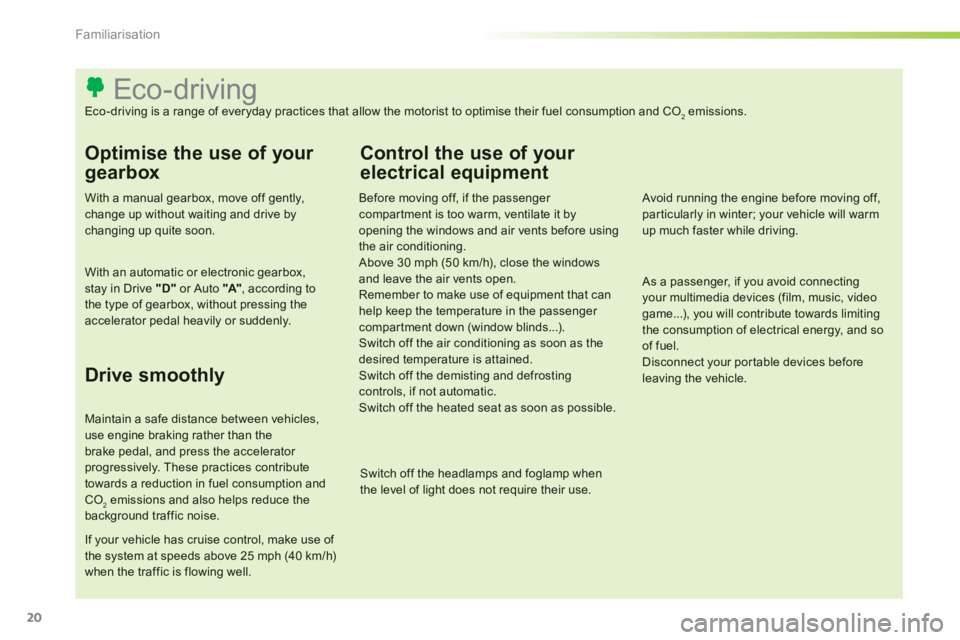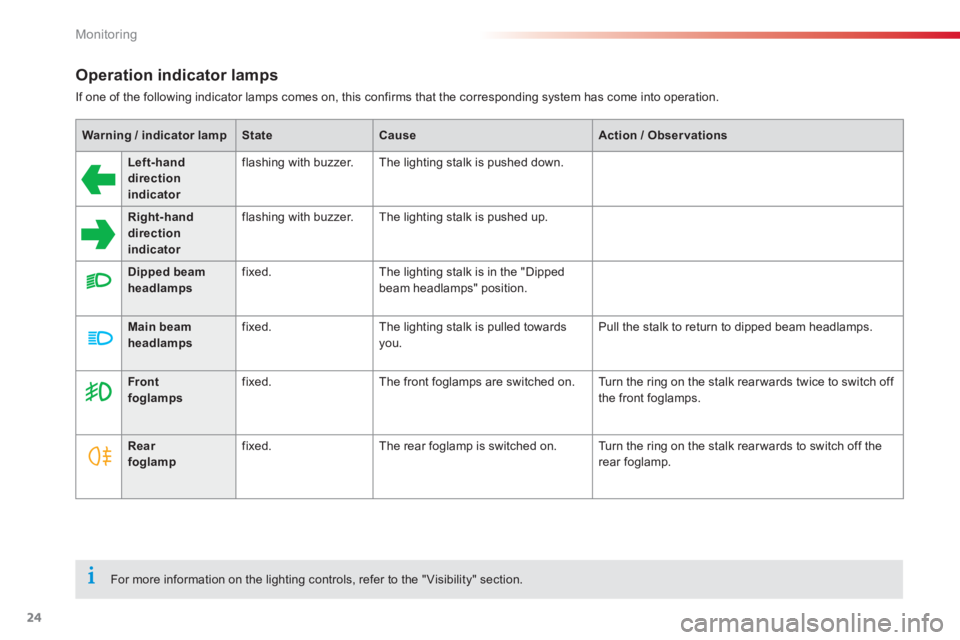CITROEN C-ELYSÉE 2012 Owner's Manual
Manufacturer: CITROEN, Model Year: 2012, Model line: C-ELYSÉE, Model: CITROEN C-ELYSÉE 2012Pages: 236, PDF Size: 5.92 MB
Page 21 of 236

.
19
Familiarisation
Driving safely
1.
Selection of limiter mode. 2.Reducing the programmed value. 3.Increasing the programmed value. 4.
Limiter On / Off.
Speed limiter "LIMIT"
85
1.Selection of cruise control mode.
2. Reducing the programmed value.3.
Increasing the programmed value.4.
Cruise control On / Off.
Cruise control "CRUISE"
87 The cruise control or speed limiter mode
appears in the instrument panel when selected.
Display in the instrument
panel
Cruise control
S
peed limiter
The settings must be made with the engine running.To be programmed or activated, the speed of
the vehicle must be above 25 mph (40 km/h),with at least 4thengaged for a manual gearbox (2 nd for an electronically controlled or automatic gearbox).
Page 22 of 236

20
Familiarisation
Eco-driving
Eco-driving is a range of everyday practices that allow the motorist to optimise their fuel consumption and CO2emissions.
Optimise the use of your
gearbox
With a manual gearbox, move off gently,change up without waiting and drive by changing up quite soon.
With an automatic or electronic gearbox, stay in Drive "D"or Auto "A"
, according to the type of gearbox, without pressing theaccelerator pedal heavily or suddenly.
Drive smoothly
Maintain a safe distance between vehicles, use engine braking rather than the brake pedal, and press the accelerator progressively. These practices contribute towards a reduction in fuel consumption and CO2 emissions and also helps reduce the background traffic noise.
If your vehicle has cruise control, make use of the system at speeds above 25 mph (40 km/h) when the traffic is flowing well.
Control the use of your
electrical equipment
Before moving off, if the passenger compartment is too warm, ventilate it byopening the windows and air vents before using the air conditioning.
Above 30 mph (50 km/h), close the windows and leave the air vents open.
Remember to make use of equipment that canhelp keep the temperature in the passenger compartment down (window blinds...).
Switch off the air conditioning as soon as the desired temperature is attained.
Switch off the demisting and defrostingcontrols, if not automatic. Switch off the heated seat as soon as possible.
Switch off the headlamps and foglamp whenthe level of light does not require their use.
Avoid running the engine before moving off,particularly in winter; your vehicle will warmup much faster while driving.
As a passenger, if you avoid connecting your multimedia devices (film, music, videogame...), you will contribute towards limitingthe consumption of electrical energy, and soof fuel.
Disconnect your por table devices beforeleaving the vehicle.
Page 23 of 236

.
21
Familiarisation
Limit the causes of excess
consumption
Spread loads throughout the vehicle; placethe heaviest items in the bottom of the boot,as close as possible to the rear seats.Limit the loads carried in the vehicle and reduce wind resistance (roof bars, roof rack, bicycle carrier, trailer...). Use a roof box inpreference.Remove roof bars and roof racks after use.
At the end of winter, remove snow tyres and refit your summer tyres.
Observe the recommendations
on maintenance
Check the tyre pressures regularly, when cold, referring to the label in the door aper ture, driver's side.Carry out this check in par ticular:- before a long journey,- at each change of season,- after a long period out of use. Don't forget the spare wheel and the tyres onany trailer or caravan.
Have your vehicle ser viced regularly (engine oil, oil filter, air filter...) and obser ve the
schedule of operations recommended by themanufacturer.
When refuelling, do not continue after the3 rd
cut-off of the nozzle to avoid any over flow.
At the wheel of your new vehicle, it is only after the first 1 800 miles (3 000 kilometres) that you will see the fuel consumption settledown to a consistent average.
Page 24 of 236

22
Monitoring
Instrument panel for petrol - Diesel
1.
Rev counter (x 1 000 rpm). 2.
Screen. 3.Speedometer (km/h).
A.Electronic or automatic gearbox
information.B.Time.C.Range (km) or
Tr i p d i s t a n c e r e c o r d e r.
D. Fuel gauge.E.
Ser vice indicator (km) then,
total distance recorder.
These two
functions are displayedsuccessively when switching on the ignitionF.Speed limiter or cruise control settings.
4.Reminder of service information
Reset the selected function to zero (trip
distance recorder or ser vice indicator)
Adjust the time.
Dials
Screen
Page 25 of 236

1
23
Monitoring
Indicator and warning lamps
Cer tain warning lamps may come onin one of two different modes. Only by relating the type of illumination to the operating status of the vehicle can itbe ascertained whether the situation isnormal or whether a fault has occurred.
When the ignition is switched on
Certain warning lamps come on for a few seconds when the vehicle's ignition isswitched on.
When the engine is started, these same
warning lamps should go off.
If they remain on, before moving off, refer to the
information on the warning lamp concerned.
Associated warnings
The illumination of cer tain warning lamps may be accompanied by an audible signal and a
message in the multifunction screen.
The warning lamps may come on continuously (fixed) or flash.
Visual indicators informin
g the driver that a system is in operation (operation or deactivation indicator lamps) or of the occurrence of a fault(warning lamp).
Page 26 of 236

24
Monitoring
Operation indicator lamps
If one of the following indicator lamps comes on, this confirms that the corresponding system has come into operation.
Warning / indicator lampStateCauseAction / Observations
Left-hand direction indicator
flashing with buzzer. The lighting stalk is pushed down.
Right-hand
direction indicator
flashing with buzzer. The lighting stalk is pushed up.
Dipped beamheadlampsfixed.The lighting stalk is in the "Dipped
beam headlamps" position.
Main beam headlampsfixed.The lighting stalk is pulled towards
you. Pull the stalk to return to dipped beam headlamps.
Frontfoglampsfixed.The front foglamps are switched on. Turn the ring on the stalk rear wards twice to switch off
the front foglamps.
Rearfoglampfixed.The rear foglamp is switched on. Turn the ring on the stalk rear wards to switch off the
rear foglamp.
For more information on the lighting controls, refer to the "Visibility" section.
Page 27 of 236

1
25
Monitoring
Warning / indicator lampStateCauseAction / Observations
Diesel engine pre-heating fixed. The ignition switch is at
the 2nd position (ignition on). Wait until the warning lamp goes off before star ting.
The period of illumination of the warning lamp is
determined by the climatic conditions (up to about
thir ty seconds in extreme climatic conditions).
If the engine does not star t, switch the ignition off and
then on, wait until the warning lamp goes off again,
then start the engine.
Parkingbrake fixed. The parking brake is applied or notproperly released. Release the parking brake to switch off the warninglamp, keeping your foot on the brake pedal.
Obser ve the safety recommendations.
For further information on the parking brake, refer to
the "Driving" section.
Foot on thebrake pedal fixed. The brake pedal must be pressed. With an electronic gearbox, press the brake pedal to start the engine (lever in position N).
With an automatic gearbox, with the engine running,
press the brake pedal before releasing the parking
brake, to unlock the lever and come out of position P . PIf you wish to release the parking brake without pressing the brake pedal, this warning lamp will
remain on.
flashin
g. With an electronic gearbox, if you hold the vehicle on an incline using
the accelerator for too lon
g, the clutchoverheats. Use the brake pedal and/or the parkin
g brake.
Page 28 of 236

26
Monitoring
Deactivation indicator lamps
If one of the following indicator lamps comes on, this confirms that the corresponding system has been switched off intentionally.This is may be accompanied by an audible signal and a message in the screen.
Warning / indicator lampStateCauseAction / Observations
Passenger's airbag systemfixed. The control, located in the glove box,
is set to the OFF
position.
The passenger's front airbag is deactivated. In this case you can install a "rear facing" child seat.Set the control to the O
N
position to activate thepassenger's front airbag.
In this case, do not fit a child seat in the rear-facing position.
ESP/ASRfixed. The button, located at the bottom
left of the dashboard, is pressed. Its
indicator lamp is on.
The E
SP/ASR is deactivated.
ESP: electronic stability programme.
ASR: anti-slip regulation.Press the button to activate the E
SP/ASR. Its indicator
lamp goes off.
The ESP/ASR system is activated automatically when
the vehicle is started.
If deactivated, the system is reactivated automaticallyfrom around 30 mph (50 km/h).
Page 29 of 236

1
27
Monitoring
Warning lamps
When the engine is running or the vehicle is being driven, illumination of one of the following warning lamps indicates a fault which requires action on
the par t of the driver.
Any fault resulting in the illumination of a warning lamp must be investigated fur ther by reading the associated message in the screen.
If you encounter any problems, contact a CITROËN dealer or a qualified workshop.
Warning / indicator lampStateCauseAction / Observations
STOP
fixed, associated with
another warning lamp. It is associated with the engine
oil pressure or the engine coolant
temperature.
Stop as soon as it is safe to do so.
Park, switch off the ignition and call a CITROËN
dealer or qualified workshop.
Service
on temporarily.Minor faults have occurred for which
there is no specific warning lamp. Identify the fault by reading the message shown in the screen, such as, for example:
- saturation of the par ticle emissions filter (Diesel).
- the power steering,
- a minor electrical fault.
-
...
For any other faults, contact a CITROËN dealer or a qualified workshop.
fixed. Major faults have occurred for which
there is no specific warning lamp. Identify the fault by reading the message shown in
the screen and then contact a CITROËN dealer or
qualified workshop.
Page 30 of 236

28
Monitoring
Warning / indicator lampStateCauseAction / Observations
Braking fixed. The braking system fluid level has
dropped significantly. You must stop as soon as it is safe to do so.
Top up with brake fluid listed by CITROËN.
If the problem persists, have the system checked by a CITROËN dealer or a qualified workshop.
+
fixed, associatedwith the ABS warning lamp. Th
e electronic brake force distribution (EBFD) system has a fault. You must stop as soon as it is safe to do so.
Have it checked by a CITROËN dealer or a qualified
workshop.
Maximum coolanttemperature
fixed red. The temperature of the cooling system is too high. Stop as soon as it is safe to do so.
Wait until the engine has cooled down before toppingup the level, if necessary.
If the problem persists, contact a CITROËN dealer or qualified workshop.